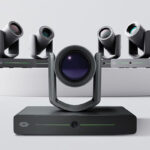There are as many ways to transmit audio as there are notes in a symphony, and when it comes to system design, the pro AV industry has a lot of proud virtuosos. Occasionally, however, hard-won mastery of complex and powerful technology can lead you to overlook simpler solutions. In many contexts, your audio transmission needs are amply covered by HDMI — even in commercial applications.
Not too long ago, the pro AV industry regarded HDMI with skepticism that bordered on disdain: It was considered a wholly consumer technology. Now, you’d be hard-pressed to find a professional source or sink that lacks an HDMI port. In the end, this technology was too capable, simple and popular to ignore as a video transmission technology.
However, HDMI’s audio capabilities remain largely overlooked. In the early days of HDMI in commercial solutions, compatibility issues and inconsistent device support made HDMI’s Audio Return Channel (ARC) look like a pale alternative to tried-and-true methods. Now, however, widespread support and expanded capabilities have made ARC and enhanced ARC (eARC) a viable option for commercial applications.
ARC: What’s the Point?
ARC and eARC allow for bidirectional transmission of audio information from a display to a sound system. Simply put, instead of having to run separate audio cabling, you can just daisy-chain source(s), display and audio with a single HDMI cable connecting the audio system and the display. The display will automatically send the audio stream for the on-screen source to the audio system: clean and simple.
Choose Your Fighter: ARC and eARC
ARC was added to the HDMI 1.4 spec in 2009. The next generation, eARC, was introduced in 2017. Both standards remain in widespread use today. So, which should you consider for your applications?
The main difference between ARC and eARC is the bandwidth. ARC has a maximum audio bandwidth of around 1 Mbps, while eARC has a maximum of up to 37 Mbps. As a result, eARC is capable of high-quality audio streams designed for theatrical or HiFi systems, such as Dolby TrueHD and DTS-HD Master Audio.
ARC, by contrast, can support compressed 5.1 surround sound audio data. In addition, lip-sync correction is an optional feature for ARC, and mandatory for eARC.
However, for eARC or ARC to work, every device and port in the signal chain must be compatible. Though eARC is not technically dependent on HDMI 2.1, you really do need a signal chain that supports HDMI 2.1 or better end-to-end in order to get the most out of it. ARC has been around for over a decade: there are a lot more ARC-compatible devices on the market than eARC-compatible devices.
In addition, eARC devices are backwards-compatible with ARC, so the ARC device ecosystem is still growing. For mono and stereo commercial applications, ARC is a reliable, stable option that will amply meet your needs. It also supports Dolby Digital Plus, making it appropriate for many streaming-media applications.
Keeping it Simple
HDMI is rarely the “first-thought” option for audio delivery in commercial applications, but it’s often fully supported by all the equipment you’re already using. Sometimes, there is no need to include dedicated audio hardware and infrastructure in a design to deliver all the features required for the application. In scenarios where cost, space or time constrain system complexity, this is critical to keep in mind.
For example, in a divisible conference room, integrators can use ARC or eARC to create a reliable system with an extremely simple architecture. When the space is undivided and the screens are all showing content from the same source, the audio system plays the corresponding content throughout the whole space. When it’s divided and the screens are showing content from different sources, the speakers in each segment of the space automatically play the content associated with the screen(s) in that segment.
This is also an efficient approach for rental and staging applications, efficiently delivering audio and video using a single cable. Notably, for larger spaces, that cable can be an eminently flexible CAT cable — the most advanced HDBaseT 3.0 extenders have full support for both ARC and eARC.
And, in the rare occasion that you encounter a sink without HDMI compatibility or ARC/eARC support, most extenders also include an analog and/or digital audio breakout as a fallback option. You can also always revert to more traditional audio distribution methods for the last 10 feet: You will still save time, money and complexity on the overall system design.
HDMI and Beyond
HDMI and its attendant extension technologies, like HDBaseT 3.0, have grown into impressively capable and mature distribution technologies. In many contexts, you can distill the whole cable plant for a simple conference room down to a single CAT cable delivering audio, video, USB, control, data and more.
As audio professionals, we know how to integrate complex, integrated solutions — but sometimes, there’s nothing more sophisticated than simplicity.
 Brandon White is director of new product design, Vanco.
Brandon White is director of new product design, Vanco.










